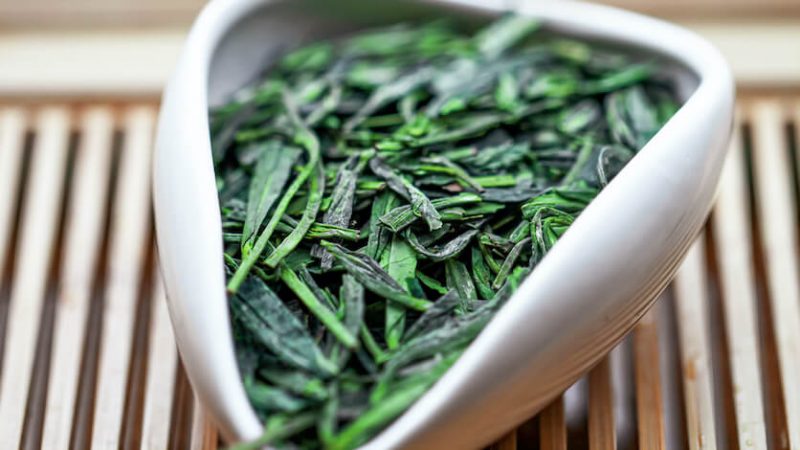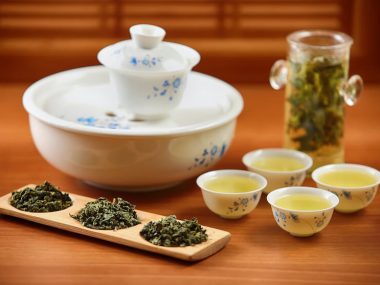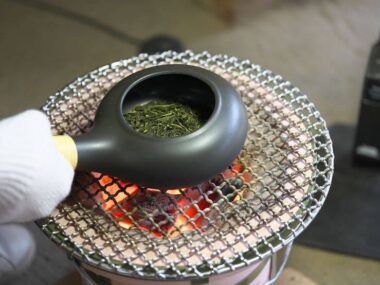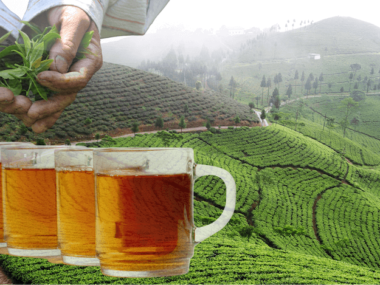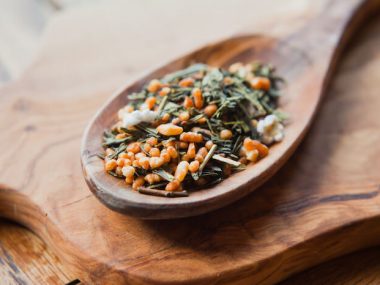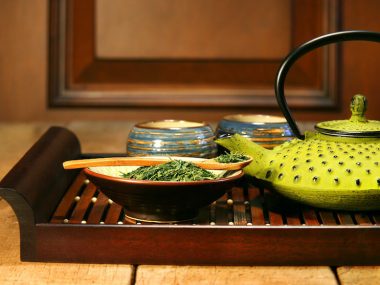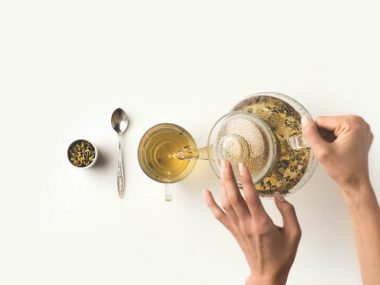Are you ready to experience the world’s highest quality green tea? Known by several names, it’s a gem that won’t disappoint your palate. There are only a few places where this tea is grown and if you buy some with any other origin, it’s not the real deal. Meet Longjing tea.
Table of Contents
What Is Longjing Tea?
Many of us find the Chinese tea world confusing because of the names of the tea. Longjing tea in China may be called Xihu Longjing, Zhejiang Longjing, Westlake Dragon Well, or Dragonwell. While there are numerous terms used to identify Longjing tea, the westernized version is typically Dragonwell while the easternized version may be any of the above names.
For the sake of simplicity, we are going to refer to it as “Longjing” for the most part. When shopping around for this tea, it is usually marketed as Dragonwell tea. However, some retailers who specialize in Asian teas will list it as Longjing.
Many readers ask about what type of tea Longjing is. It is a green tea grown only in two provinces of China. Longjing green tea (Dragonwell tea) is the most common tea consumed in China and is quickly catching on around the world.
Where Does Longjing Tea Come From?
It’s interesting to find out more about what province makes Dragonwell tea (Longjing). Longjing is called “Dragonwell ” because of claims that an emperor who was asleep had a dragon come to him in his sleep to reveal how the province the emperor ruled was to come under great wealth. The emperor was so taken by his dream that he decided to name the area he lived in “Longjing” (translation: “dragon well.” )
Another legend of Longjing tea’s origin was when Emperor Qianlong brought tea leaves home from a visit to Lion Peak Mountain while in Hangzhou. He was called home due to his mother becoming ill and without thinking he hid the tea leaves within his clothing. Upon seeing his mother (Empress Dowager) the fragrance of the tea leaves wafted over to his mother and piqued her curiosity. She fell in love with the tea once he gave her a gift of it which he ordered. Longjing tea became a tribute in honor of the Empress.
Although there’s no city or town named “Longjing” in China, there are temples, tea farms, tea shops, and significant tourism areas centered around the folklore of Longjing and the Longjing tea industry. The Longjing tea culture has exploded in growth in the Zhejiang Province just southwest of Hangzhou.
Harvesting (Flushes)
Longjing tea harvests (flushes) are done within a very short window that happens to fall between February to April.
With Longjing, the first flush occurs in late February to March. The second flush occurs around March to April. This flush is known as ““Pre-Qing-Ming” (before the Qing Festival.) Another flush occurs mid to late April which is known as “Qing-Yu” (before the rain.) Once these flushes are past, the tea farmers trim the tea plants back for next year’s tea crop.
Tea connoisseurs will be quick to advise you not to purchase first flush Longjing because of the hefty price you’ll pay. Instead, they’ll tell you that the “Pre-Qing-Ming” flush is the one to buy because the tea has a stronger taste whereas the first flush is more mellow and delicate.
Processing Of Longjing Tea
After harvesting, the tea leaves are placed in a large wok and pan-fired like many other Chinese teas. This heating process prevents the leaves from oxidizing, thus allowing them to maintain the rich green hue and the integrity of nutrients. This type of green tea contains high amounts of catechins, vitamin C, and amino acids that offer a range of health benefits.
Withering
Tea leaves are plucked and brought back to the processing plant where they will be allowed to rest for a certain amount of time. During this phase, the enzymes within the tea leaves begin to oxidize.
Fixing
The withered tea leaves are now heated through pan-frying to stop oxidation. The Chinese have two methods they use for this step in processing. The traditional method is the “old school” way where the tea leaves are placed into a wok and heated to about 200 degrees (F) (180 degrees C) while hand tossing them to prevent burning. The modern way of fixing tea leaves is by placing the tea leaves into a machine that automatically heats the tea leaves up to the precise temperature.
If you can get your hands on Longjing pan-fried (and shaped) by hand (the traditional way,) you get a much better quality tea compared to that done by machine. The traditional method causes the tea to be a darker green, more pronounced roasty, nutty flavor, and have a more refined shape. Because of convenience and faster production, almost all of Longjing tea is processed by machines.
Shaping
Once the tea leaves have undergone fixing, they are now rolled and shaped either by hand or a machine for 15 minutes. The traditional method of shaping is done in a heated work where a person’s hand continuously keeps the tea leaves rolling and moving around. The risk of burning their hands is something they contend with as it happens often.
The modern way of shaping tea leaves is done by a machine. The tea leaves that are placed into a machine for fixing automatically get moved onto a hot plate where a series of bars roll and move the leaves around simulating the movements when done by hand.
Sifting and Grading
After shaping has been completed, the tea leaves are dumped out onto bamboo trays where they are hand-sifted. Small tea leaves drop through the sifter tray while the larger ones stay on the tray. This is how the tea is graded. The larger the leaf, the higher the grade which fetches a higher price.
Off To Market
The tea leaves are then packaged and sent to traders who market the tea to wholesalers and retailers.
Why Is Longjing Tea So Expensive?
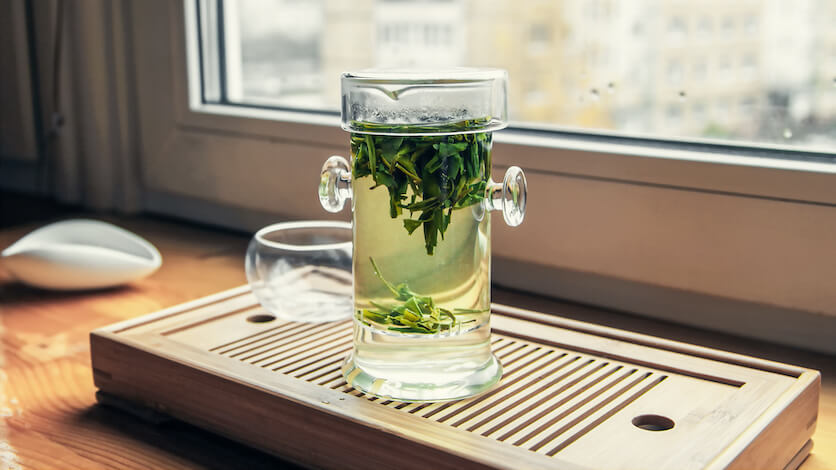
Longjing tea from the first flush is one of the most expensive green teas in China. World Tea News published an article in 2012 on the exorbitant price Longjing brought. It yielded a whopping $57,024 USD (360,000 Yuan) for about two pounds of tea!
Many factors play a role in the high price of Longjing tea. The area it’s grown in, the method of processing, and the age of the tea plant. If the tea is grown in Xihu, just south of Hangzhou in the Zhejiang Province, it’s going to be costly. If the tea is processed by hand (the traditional method) it will be costly. The older the tea plant, the more costly the tea will be.
What Does Longjing Tea Taste Like?
Longjing tea is mellow, nutty, creamy, sweet, and has a subtle grassiness to it while the aroma is floral. This tea will be stronger and darker if it has been processed by hand (traditional method) and has a more pronounced roasty, nutty taste compared to the tea processed by machine which isn’t quite as bold.
Does Longjing Tea Have Caffeine?
A six-ounce cup of tea can have up to 40 mg of caffeine. If you are like some of us who are caffeine sensitive, you may wonder if it is okay to drink this tea every day or not. Moderation is the key and if you stay within the recommended daily intake limit of 400 mg (per the Food and Drug Administration), you should be fine.
Is Longjing Tea Good For You?
Green tea is known for having higher levels of phenols which are the constituents our bodies benefit from. Pharmacy Times published an article noting how Longjing tea helps to reduce the risk of stroke and heart attack.
A separate research study published (“Beneficial Effects Of Green Tea: A Literature Review”) mentions that green tea is an antioxidant, antidiarrheal, boosts bone health, promotes renal health, may help to reduce neurological disorders such as dementia, Parkinson’s, and Alzheimers.
Are There Any Side Effects Of Longjing Tea?
Overconsumption of any tea can cause side effects such as rapid heartbeat, caffeine jitters, high blood pressure, and digestive upset. Because Longjing tea is caffeinated, it may cause caffeine-associated side effects.
If you are taking medication, have any medical disorders, or are undergoing chemotherapy or radiation, it’s best to consult with your healthcare provider before drinking tea. The same applies if you are pregnant or nursing.
How To Brew Longjing Tea
If you are one of the lucky few who manage to snag “Pre-Qing-Ming” Longjing tea but aren’t sure how to brew the perfect cup of this magnificent green tea, we will walk you through it.
Ingredients
- 2 cups of water
- 2 teaspoons of loose-leaf Longjing tea (also known as Dragonwell)
Directions
- Heat the water until it reaches 175 degrees (F) (about 80 degrees C.)
- Remove from the heat.
- Place the loose-leaf tea into a tea infuser.
- Drop the tea infuser into the teapot.
- Pour the hot water into the teapot.
- Cover and allow to steep for 3 minutes.
- Pour the tea into a teacup and enjoy.
Tip: Electric kettles allow you to control the temperature of the water. When brewing green tea, it’s important not to overheat the water or it can literally cook the tea leaves.
A Must-Try Lovely Green Tea
If you are exploring various green teas, we highly recommend Longjing tea (“Pre-Qing-Ming”.) Be sure to check the origin because if it’s not Xihu or Zheijing, you’ll be missing out on experiencing the very best tea China has to offer!
